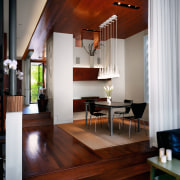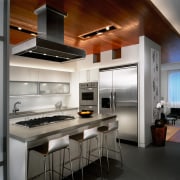Accentuate the positive
Limitations imposed by the city location of this house have been overcome with innovative design solutions
The old cliche that necessity is the mother of invention can easily be applied to architecture. For rather than being a deterrent to good design, a location's unusual size and shape can have a beneficial influence on the creative process.
The challenges imposed by the long, narrow site of this house were compounded by the lack of a rear alleyway for parking. This meant that the garage had to be built out front.
Architect Richard Blender limited the visual impact of this strictly utilitarian area of the home by cantilevering the house over the garage door.
"The garage sits in shadow so you don't notice it. The primary focus is on the balcony," he says.
Positioned beside the front entrance, the balcony is defined by linear paneling. From the road, the wooden bifold doors appear to sit inside a picture frame.
The doors open onto the kitchen for a seamless indoor-outdoor flow. The balcony also provides homeowners Giacomo and Kristyn Caliendo with an outdoor space and a view of the sculpture park across the road.
"We wanted to blur the lines between inside and outside," says Giacomo Caliendo, whose company built the house.
Inside the first floor, a progression of gradually descending rooms creates a telescoping effect, the floor dropping by two steps, so that the kitchen is 10ft high, the dining area 12ft and the living room 14ft.
"The stepping down from room to room is connected through the ceiling plane. By the time you arrive in the living room, it has a kind of loft-like appeal," says Blender.
"We have been able to achieve an expansive feeling on a narrow site by emphasizing the verticality of the design. In architectural terms, this is called using the section of the building."
Although one living space opens onto another, a variety of hard and soft barriers such as bifold doors and curtain screens ensures each area can become separate and enclosed.
In a city location with close neighboring properties, natural light can sometimes be sacrificed for privacy. Blender solved this design conundrum by creating glass panels on the top floor balcony which allow the light to shine in from above.
This light illuminates the second floor, an area of the home that is traditionally the darkest level in a city townhouse. The open stairwell then carries the light through to the lower living room floor.
The top floor courtyard balcony is accessed through the master suite. As in the rest of the house, design continuity is achieved by using a similar material palette inside and outside. For example, the bathtub's cast concrete surround echoes the look of the stone panels on the exterior facade.
On the other side of the house, a wooden walkway with steel balustrades leads from the main living floor to a sunken garden.
Blender says that because there is no garage out back, the space can be used as an private outdoor area. One that contrasts nicely with the public view enjoyed on the other side of the house.
Credit list
Interior designers
Kitchen manufacturer
Structural engineer
Roof
Paints
Heating
Drapes
Backsplash
Faucets
Refrigerators
Flooring
Kitchen designer
Builder
Siding
Lighting designer
Blinds
Kitchen countertop
Sink
Oven, cooktop, dishwasher and ventilation
Bathtub and faucets
Story by: Trendsideas

Poggenpohl Kitchens
Cabinetry that will last for years
Home kitchen bathroom commercial design
Connected to the ocean
Masculine meets mixed use
Contrast and connection













